 W
WThe Basic School (TBS) is where all newly commissioned and appointed United States Marine Corps officers are taught the basics of being an "Officer of Marines". The Basic School is at Camp Barrett, Quantico, Virginia, in the south-west of the Marine Corps Base Quantico complex. Each year over 1,700 new officers are trained, representing such commissioning sources as the U.S. Naval Academy, Officer Candidates School, and Marine Corps Limited Duty Officer (LDO) and Warrant Officer accession programs.
 W
WCamp Peary is an approximately 9,000 acre U.S. military reservation in York County near Williamsburg, Virginia. Officially referred to as an Armed Forces Experimental Training Activity (AFETA) under the authority of the Department of Defense, Camp Peary hosts a covert CIA training facility known as "The Farm", which is used to train officers of the CIA's Directorate of Operations, as well as those of the DIA's Defense Clandestine Service, among other intelligence entities. Camp Peary has a sister facility, "The Point", located in Hertford, North Carolina.
 W
WCamp Pendleton is a 325-acre (1.32 km2) state military reservation in Virginia Beach, Virginia, named after Confederate Brigadier General William N. Pendleton, who served as Robert E. Lee's chief of artillery during the American Civil War. It lies on the Atlantic coast slightly east of Naval Air Station Oceana.
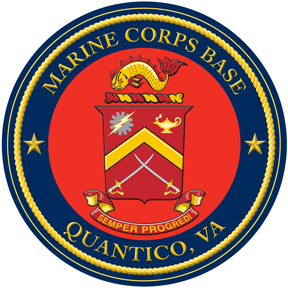 W
WMarine Corps Base Quantico is a United States Marine Corps installation located near Triangle, Virginia, covering nearly 55,148 acres (86.169 sq mi) of southern Prince William County, Virginia, northern Stafford County, and southeastern Fauquier County. Used primarily for training purposes, MCB Quantico is known as the "Crossroads of the Marine Corps".
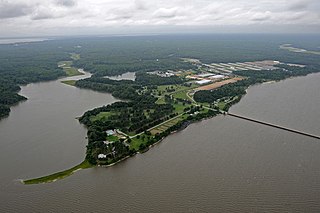 W
WCheatham Annex is a Naval Base, located near Williamsburg, Virginia on the York River approximately 35 miles northwest of Norfolk in the heart of the famous Jamestown–Williamsburg–Yorktown "Historic Triangle." Although Cheatham Annex was not commissioned until June 1943, the land on which the base is located can claim the unique distinction of having been associated with every conflict involving the United States freedom and independence. The mission of Cheatham Annex includes supplying Atlantic Fleet ships and providing recreational opportunities to military and civilian personnel.
 W
WThe Fort Eustis Military Railroad is an intra-plant United States Army rail transportation system existing entirely within the post boundaries of the United States Army Transportation Center and Fort Eustis (USATCFE), Fort Eustis, Virginia. It has served to provide railroad operation and maintenance training to the US Army and to carry out selected material movement missions both within the post and in interchange with the US national railroad system via a junction at Lee Hall, Virginia. It consists of 31 miles (50 km) of track broken into three subdivisions with numerous sidings, spurs, stations and facilities.
 W
WHampton Roads Port of Embarkation was the Army command structure and distributed port infrastructure in the Hampton Roads area of Virginia supporting movement of personnel and cargo overseas. It had been activated as the Newport News Port of Embarkation in World War I, deactivated, then reactivated 15 June 1942.
 W
WHenderson Hall is a military installation of the United States Marine Corps (USMC) located in Arlington County, Virginia, near the Pentagon, on the southern edge of the Arlington National Cemetery and next to Fort Myer. Currently, it is part of Joint Base Myer–Henderson Hall. Henderson Hall is named for Brevet Brigadier General Archibald Henderson, the fifth and longest-serving Commandant of the Marine Corps.
 W
WThe Howlett Line was a critical Confederate earthworks dug during the Bermuda Hundred Campaign of the United States Civil War in May 1864. Specifically, the line stretched across the Bermuda Hundred peninsula from the James River to the Appomattox River. It was named for the Dr. Howlett's House that overlooked the James River at the north end of the line. The Howlett Line became famous as the "Cork in the Bottle" by keeping the 30,000-man strong General Butler's Army of the James at bay.
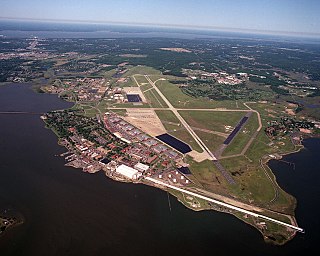 W
WJoint Base Langley–Eustis is a United States military facility located adjacent to Hampton and Newport News, Virginia. The base is an amalgamation of the United States Air Force's Langley Air Force Base and the United States Army's Fort Eustis which were merged on 1 October 2010. The base was established in accordance with congressional legislation implementing the recommendations of the 2005 Base Realignment and Closure Commission. The legislation ordered the consolidation of the two facilities which were nearby, but separate military installations, into a single Joint Base, one of 12 formed in the United States as a result of the law.
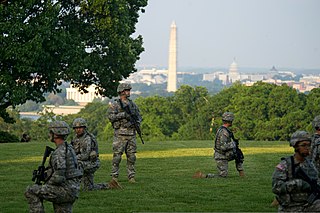 W
WJoint Base Myer–Henderson Hall is a Joint Base of the United States military that is located around Arlington, Virginia which is made up of Fort Myer (Arl), Fort McNair, and Henderson Hall. It is the local residue of the Base Realignment and Closure, 2005 process. It is commanded by the United States Army but has resident commands of Army, Navy, & Marines. Most conspicuous is the Arlington National Cemetery Honor Guard.
 W
WJoint Expeditionary Base Little Creek–Fort Story (JEBLC-FS), is a Joint Base of the United States military that is located in Virginia Beach, Virginia. The installation is made up of former U.S Army post Fort Story and Naval Amphibious Base Little Creek. It was created as the result of the Base Realignment and Closure, 2005 process. It is commanded by the United States Navy.
 W
WLambert's Point Deperming Station is a United States Navy deperming facility located in the Elizabeth River just off Lambert's Point, Norfolk, Virginia, United States. It was built in the mid-1940s and services the U.S. Atlantic Fleet.
 W
WJoint Expeditionary Base–Little Creek (JEB–LC), formerly known as Naval Amphibious Base Little Creek and commonly called simply Little Creek, is the major operating base for the Amphibious Forces in the United States Navy's Atlantic Fleet. The base comprises four locations in three states, including almost 12,000 acres (4,900 ha) of real estate. Its Little Creek location in Virginia Beach, Virginia totals 2,120 acres (860 ha) acres of land. Outlying facilities include 350 acres (140 ha) located just north of Training Support Center Hampton Roads in Virginia Beach, and 21 acres (8.5 ha) known as Radio Island at Morehead City, North Carolina, used for U.S. Coast Guard ships and personnel as well as serves as an amphibious embarkation/debarkation area for U.S. Marine Corps units at Marine Corps Base Camp Lejeune, North Carolina. It is also home to the armed forces school of music.
 W
WMarine Corps Air Facility Quantico is a United States Marine Corps airfield located within Marine Corps Base Quantico, Virginia. It was commissioned in 1919 and is currently home to HMX-1, the squadron that flies the President of the United States. The airfield is also known as Turner Field, after Colonel Thomas C. Turner, a veteran Marine aviator and the second director of Marine Corps Aviation, who lost his life in Haiti in 1931.
 W
WMarine Corps Base Quantico is a United States Marine Corps installation located near Triangle, Virginia, covering nearly 55,148 acres (86.169 sq mi) of southern Prince William County, Virginia, northern Stafford County, and southeastern Fauquier County. Used primarily for training purposes, MCB Quantico is known as the "Crossroads of the Marine Corps".
 W
WNaval Air Station Oceana or NAS Oceana is a United States Navy Naval Air Station located in Virginia Beach, Virginia. NAS Oceana is under the jurisdiction of Navy Region Mid-Atlantic and is the headquarters of Strike Fighter Wing Atlantic and Carrier Air Wings 1, 3, 7 and 8. As home to all east coast strike fighter jet squadrons, the Naval Air Station is classified as a master jet base. The airfield is known as Apollo Soucek Field, named after Lieutenant Apollo Soucek, a Navy Test Pilot who set the global altitude record in 1930 by flying a Curtiss "Hawk" biplane to an altitude of 43,166 feet.
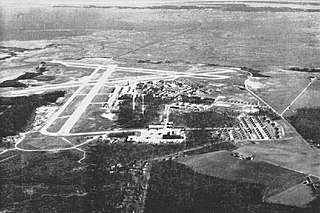 W
WNaval Auxiliary Air Station Chincoteague was a U.S. Navy Auxiliary Air Station near Chincoteague Island, Virginia. In 1941, the United States entered World War II; early the following year, the Germans torpedoed two merchant ships off the Assateague coast. To guard the coast, the United States Army established two small posts on Virginia's Eastern Shore, one each at Accomac and Chincoteague. The Navy established the Chincoteague Naval Auxiliary Air Station in 1943, across from Chincoteague on the mainland. One young pilot being trained there, future president George Herbert Walker Bush, got in trouble for "buzzing" the house of a young woman he had met at a dance.
 W
WNaval Station Norfolk Chambers Field (IATA: NGU, ICAO: KNGU, FAA LID: NGU), commonly known as just Chambers Field, is a military airport in Norfolk, Virginia that is a part of Naval Station Norfolk. It supports naval air forces in the United States Fleet Forces Command, those operating in the Atlantic Ocean, Mediterranean Sea, and Indian Ocean.
 W
WThe United States Naval Surface Warfare Center Dahlgren Division (NSWCDD), named for Rear Admiral John A. Dahlgren, is located in Dahlgren, Virginia, with a geographically separated command, Naval Surface Warfare Center Dahlgren Division Dam Neck Activity (NSWCDDDNA), located in Virginia Beach, VA, in close proximity to the largest fleet concentration area in the Navy. NSWCDD is part of the Naval Surface Warfare Centers under the Naval Sea Systems Command (NAVSEA). The NSWCDD was initially established 16 October 1918 as a remote extension of Maryland's Indian Head Proving Ground used for testing naval guns. The Dahlgren site was named the Lower Station, Dahlgren Naval Proving Ground when it first opened. The location on the Potomac River was specifically chosen for the development of a long ballistic test range on the Potomac River, required for the testing of modern, high-powered munitions.
 W
WThe Navy Annex was a building near the Pentagon in Arlington, Virginia mainly used as offices for the United States Department of the Navy. The facility was also known as Federal Office Building 2. It was demolished in 2013 to make room for an expansion of Arlington National Cemetery and other uses.
 W
WThe Norfolk Naval Shipyard, often called the Norfolk Navy Yard and abbreviated as NNSY, is a U.S. Navy facility in Portsmouth, Virginia, for building, remodeling and repairing the Navy's ships. It is the oldest and largest industrial facility that belongs to the U.S. Navy as well as the most comprehensive. Located on the Elizabeth River, the yard is just a short distance upriver from its mouth at Hampton Roads.
 W
WThe Pentagon is the headquarters building of the United States Department of Defense. As a symbol of the U.S. military, the phrase The Pentagon is also often used as a metonym for the Department of Defense and its leadership.
 W
WTysons Corner Communications Tower, also known as Site E, is a classified United States military microwave tower located in Tysons Corner, Virginia. The tower is administered by the United States Army from Fort Belvoir.
 W
WThe United States Army Engineer Research and Development Laboratory aka ERDL, was a United States Army Corps of Engineers research facility located at Fort Belvoir, Virginia.
 W
WWarrenton Training Center (WTC) is a classified United States government communication complex located in the state of Virginia. Established in 1951, it comprises four discrete stations located in Fauquier and Culpeper counties.
 W
WDuring World War II, the United States Army Air Forces (USAAF) established numerous airfields in Virginia for training pilots and aircrews of USAAF fighters and bombers.